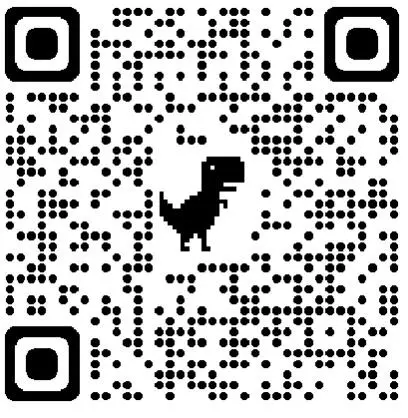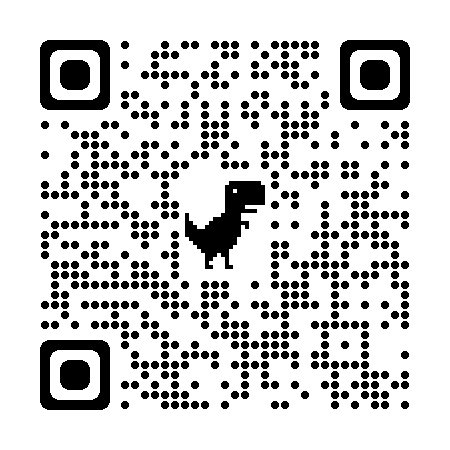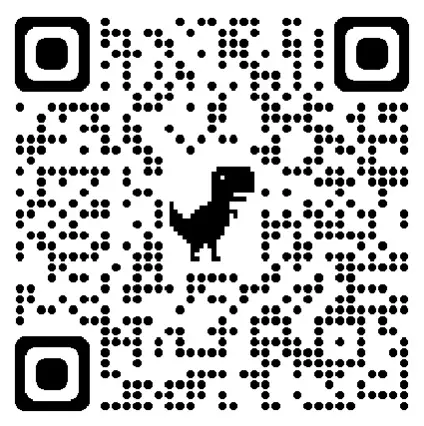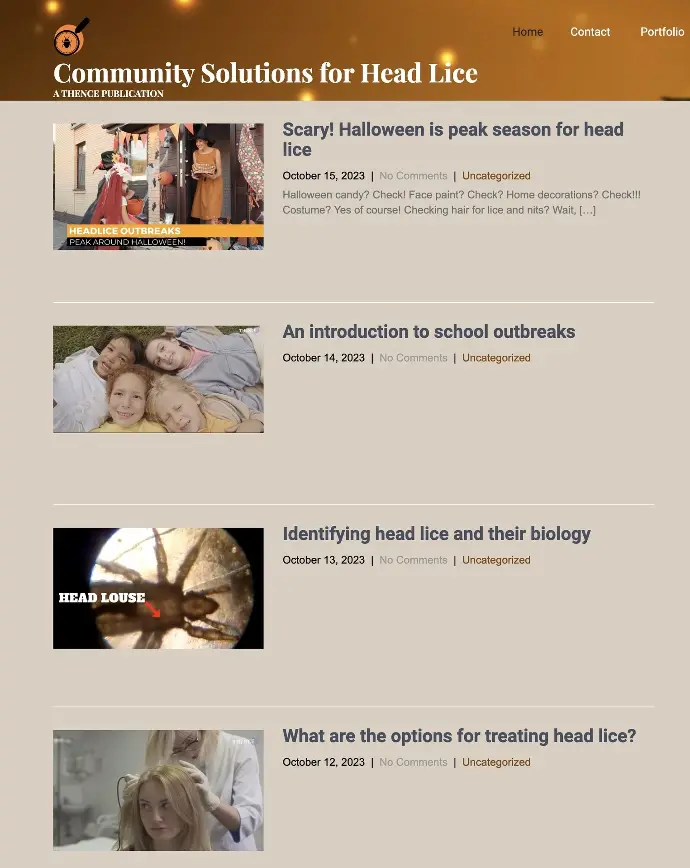ID: Brown, yellow, and read leaves in front of a white background.
Although head lice outbreaks are not a medical emergency, strong feelings of disgust, embarrassment, and stress typically follow. Often accusations and finger pointing fly between adults due to the major stigma of having a child with a case of head lice. “I have heard and observed horrible exchanges over head lice outbreaks.” Says Dr. Katherine Schlatter Co-founder at THENCE LLC. “While head lice cases are easily treated, it is the time needed, the anxiety, and fear of costly treatments that causes the most stress among parents.”

Trick or Treat? Scan to find out!
ID: A QR code to the left with a dinosaur in the center and a woman in an orange dress and black witch hat to the right is coming out of a house decorated for Halloween to give candy to trick or treaters. Text placed on top of the woman reads, "Trick or Treat? Scan to find out!". Beneath is a link, "Visit module".
The acronym SEL stands for Social and Emotional Learning, while DEI stands for Diversity Equity and Inclusion. In Community Solutions for Head Lice our health oriented e-learning course, technical knowledge and procedures are details but the e-learning module also includes micro lessons in awareness and improvement of adults' SEL skills, as well as cultural competency around all hair textures. Indeed SEL and DEI skills figure into two of the main learning objectives that should accompany the key learning goal which is to gain knowledge of procedures and technical skills for removing lice from a child’s hair and scalp.
“Because I am a parent of three, I have observed that the moment cases start popping up in school also becomes the moment that we as adults begin to forget our social and emotional skill sets. This is too bad, because children really need to see us handling a minor problem such as a head lice case with practical knowledge, and care reactions, but not outsized disgust.” She adds.
Scan to see micro lesson or, click below

ID: To the right is a QR code leading to the headlice module with a dinosaur in the center. To the left is the other half of the Halloween scene seen in the image above. Two trick or treaters in costumes walking up to the front door decorated for the holiday underneath text reading, "Scan to see micro lesson or, click below.". Below is the link, "Visit module".
Dr. Schlatter initiated this health education module not only to provide practical, safe and affordable technical advice, but also to counter misinformation, and poor culturally competency around diverse hair textures.
For this reasons Dr. Schlatter saw the opportunity to offer micro lessons in Social and Emotional Learning (SEL) alongside the practical and technical advice to counter head lice cases, or reoccurrence in previously treated hair. She saw that school educators, health educations and nurses can take advantage of heightened emotions to talk about key concepts like stigma, isolation, and community cohesion when facing the challenges of head lice cases among students.
How does the e-learning module achieve this? “We offer an inquiry-based method that asks the user to think about key questions through interactive exercises." She explained further that the teaching goal is not only to offer education about the practical aspects of head lice biology, nit and lice removal skills. There is the incorporation of a narrative and drama-based format that prompts learners to perhaps reflect, "Oh, I had that reaction , previously, why was that?" In this narrative format Dr. Schlatter explains that the pedagogy leads learners to become familiar with how stigma unfolds and gets perpetuated, or how misinformation gets repeated.
Co-Founder and THENCE Partner Andrea Patterson, an Obie award-winnning actor and teaching artist, brought her own testimony to the module. She shares a real experience in which her African American daughter’s styled hair was undone by a school nurse to perform a head lice check. After the check the nurse could not put the hair back in the style. The school nurse knew little about textured hair types, and the fact that coily hair is far less vulnerable, if not immune, to head lice infestations.

ID: To the right is a QR code leading to the headlice module with a dinosaur in the center. To the left is the other half of the Halloween scene seen in the first image above. Two trick or treaters in costumes walking up to the front door decorated for the holiday underneath text reading, "Scan to hear Mom's testimonial, or click button". Below is the link, "Visit Testimonial".
The nurse’s lack of of cultural competency in this area led to the child feeling exposed to ridicule as her hair remained conspicuously undone for the remainder of the school day. Ms. Patterson relates how stigmas around head lice, or for example, naturally coily hair textures, are housed in misinformation, discrimination, shame and fear. A mixture like that can have damaging effects on children as well as their parents. Internalized shame, for example, often leads to absenteeism, truancy, skipped classes, or missed work, due to embarrassment, insomnia, or a lack of school belonging, she explained.
Beings able to identify hurtful language, for example, is part of building the key knowledge around social and emotional learning among students. “However, the adults must take the lead by not using stigamtizing language or behaviours like gestures of disgust when discussing head lice.” according to Dr. Schlatter.
Can administrators, educators, parents and guardians be more conscious in how they handle head lice cases and school outbreaks? “Yes, and we are here to help!” Says Dr. Schlatter who is also health education specialist with the MCHES certification. “We have done a lot of research into stigma and head lice outbreaks. Quite sadly the literature suggests that the strong emotions during these non-emergency health challenges are rarely addressed, but they really need attention.”

ID: Screenshot of head lice web page in fall browns. There are four thumbnails to the left with each video's metadata to the right.
FREE access!
In the run-up to Halloween THENCE is offering Community Solutions for Head Lice module for free to learning communities.
This is why this week and next in the run-up to Halloween THENCE is offering the Community Solutions for Head Lice module course for free to learning communities. It is especially intended for the community school ecosystem and it’s also a module that demonstrates how THENCE micro lessons for professional development work for even the busiest of educators and health providers. The module reviews the most effective, proven and safest ways to treat head lice infestation and sustain lice-free heads of hair. In addition it tackles the never-talked about issues of stigma, the finger-pointing, and how to counter the out-sized emotional reactions to school head lice cases.
"There are other major problematic barriers to head lice treatment. These include time-commitment, costs, and the emotional toll that whole-household treatments can take on a family. " Explained Dr. Schlatter. These are barriers to completing treatment, and these barriers often lead to reoccurring cases for weeks or months, which only exasperates school nursing staff, teachers, family members, and administrators.
"There are other major problematic barriers to head lice treatment. These include time-commitment, costs, and the emotional toll that whole-household treatments can take on a family. "
Why is the THENCE Community Head Lice Solutions e-learning module so unique? It is the first holistic approach to school community head lice outbreaks with a health equity lens that digs deeper into why outbreaks are so pervasive, difficult to end, but also the cause of collateral damage among community members who are teased, or worse face isolation from the school community.
This training offers evidence-based set of tools for communicating the harmful affects of stigmatizing language and school-friendly strategies that better support families with reoccurring head lice infestations.
Register below with the name of your school to get an additional free month of micro lessons that meet your state or district's Professional Development requirements. Remember that when staff and faculty do just three minutes a day for each school day of the year they can quickly complete 15 hours of PD without missing classroom time or personal time.